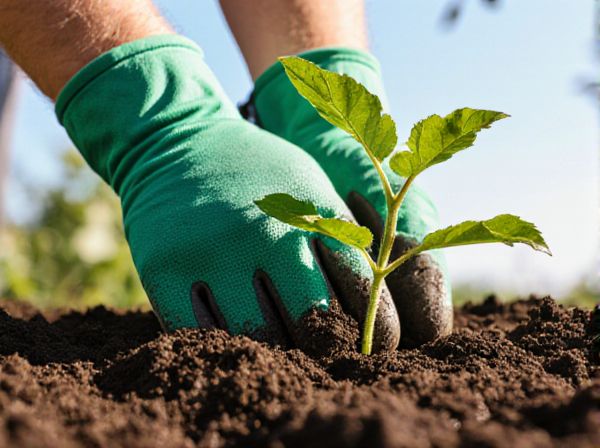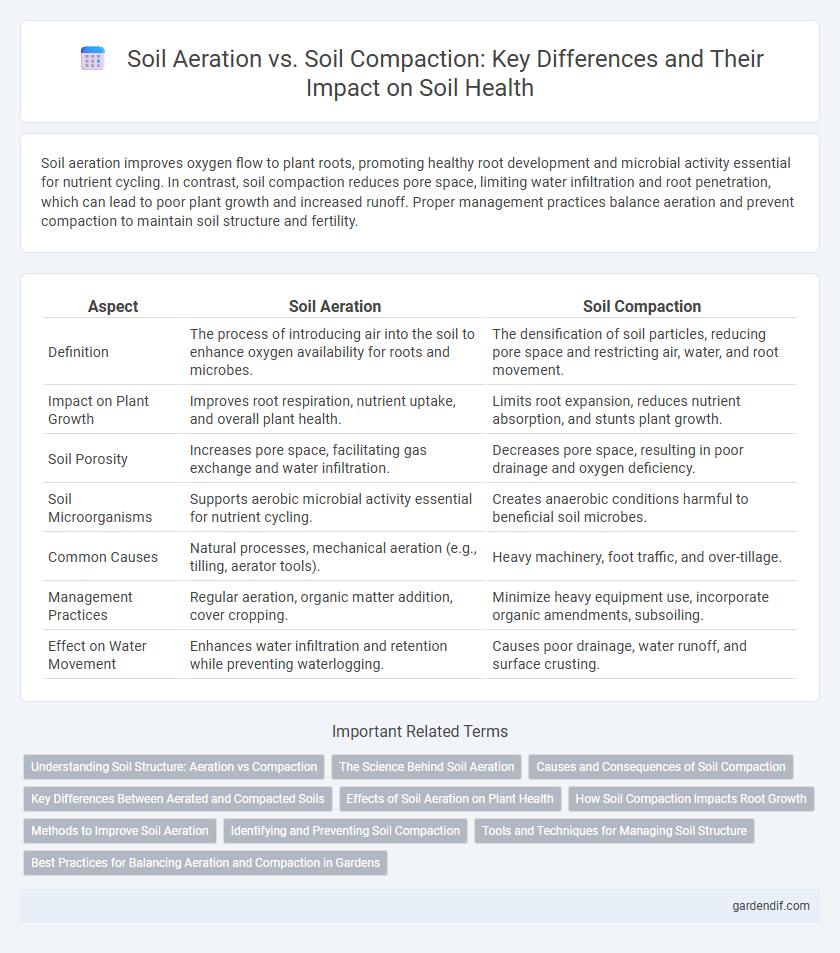
Soil aeration vs Soil compaction Illustration
Soil aeration improves oxygen flow to plant roots, promoting healthy root development and microbial activity essential for nutrient cycling. In contrast, soil compaction reduces pore space, limiting water infiltration and root penetration, which can lead to poor plant growth and increased runoff. Proper management practices balance aeration and prevent compaction to maintain soil structure and fertility.
Table of Comparison
| Aspect | Soil Aeration | Soil Compaction |
|---|---|---|
| Definition | The process of introducing air into the soil to enhance oxygen availability for roots and microbes. | The densification of soil particles, reducing pore space and restricting air, water, and root movement. |
| Impact on Plant Growth | Improves root respiration, nutrient uptake, and overall plant health. | Limits root expansion, reduces nutrient absorption, and stunts plant growth. |
| Soil Porosity | Increases pore space, facilitating gas exchange and water infiltration. | Decreases pore space, resulting in poor drainage and oxygen deficiency. |
| Soil Microorganisms | Supports aerobic microbial activity essential for nutrient cycling. | Creates anaerobic conditions harmful to beneficial soil microbes. |
| Common Causes | Natural processes, mechanical aeration (e.g., tilling, aerator tools). | Heavy machinery, foot traffic, and over-tillage. |
| Management Practices | Regular aeration, organic matter addition, cover cropping. | Minimize heavy equipment use, incorporate organic amendments, subsoiling. |
| Effect on Water Movement | Enhances water infiltration and retention while preventing waterlogging. | Causes poor drainage, water runoff, and surface crusting. |
Understanding Soil Structure: Aeration vs Compaction
Soil aeration enhances the movement of air, water, and nutrients through soil pores, promoting healthy root growth and microbial activity. In contrast, soil compaction reduces pore space, restricting gas exchange and impeding root penetration, which leads to poor plant development. Understanding the balance between aeration and compaction is essential for maintaining optimal soil structure and fertility.
The Science Behind Soil Aeration
Soil aeration enhances oxygen availability by creating pore spaces that improve root respiration and microbial activity, crucial for nutrient cycling and plant growth. In contrast, soil compaction reduces these pores, limiting gas exchange and water infiltration, which stresses plant roots and decreases soil fertility. The science behind soil aeration emphasizes maintaining optimal soil structure to balance air, water, and nutrient flow essential for healthy ecosystems.
Causes and Consequences of Soil Compaction
Soil compaction occurs when heavy machinery, foot traffic, or repeated tillage compress soil particles, reducing pore space and limiting air flow. This diminished aeration restricts oxygen availability to plant roots and soil microorganisms, impairing root growth and nutrient uptake. Consequences include increased water runoff, reduced water infiltration, and lower crop yields due to impaired soil structure and biological activity.
Key Differences Between Aerated and Compacted Soils
Soil aeration improves oxygen availability and water infiltration by creating pore spaces, whereas soil compaction reduces pore space, limiting root growth and nutrient uptake. Aerated soils enhance microbial activity and promote healthy plant development, while compacted soils increase runoff and erosion risks. Effective soil management requires maintaining optimal structure to balance aeration and avoid compaction for sustainable crop yields.
Effects of Soil Aeration on Plant Health
Soil aeration significantly improves plant health by enhancing oxygen availability, which stimulates root respiration and nutrient uptake. Improved aeration reduces soil compaction, allowing roots to expand more easily and increasing microbial activity essential for nutrient cycling. Well-aerated soils promote stronger root systems, greater water infiltration, and overall increased plant growth and resilience.
How Soil Compaction Impacts Root Growth
Soil compaction significantly reduces pore space, limiting oxygen availability essential for root respiration and nutrient uptake. Compacted soil increases resistance to root penetration, restricting root expansion and overall plant stability. Reduced aeration caused by compaction leads to anaerobic conditions, impairing microbial activity and further diminishing soil fertility.
Methods to Improve Soil Aeration
Improving soil aeration involves techniques such as tilling, which breaks up compacted layers and increases pore space for oxygen diffusion and root respiration. Incorporating organic matter like compost or cover crops enhances soil structure by promoting microbial activity and maintaining porosity. Installing drainage systems or using mechanical aerators can further alleviate compaction, allowing better gas exchange and water infiltration essential for healthy plant growth.
Identifying and Preventing Soil Compaction
Soil compaction reduces pore space, limiting air, water, and nutrient movement essential for root growth and soil aeration. Identifying compacted soil involves checking for surface crusting, poor water infiltration, and shallow root systems. Preventing soil compaction requires minimizing heavy machinery use, maintaining adequate organic matter, and implementing proper crop rotation techniques.
Tools and Techniques for Managing Soil Structure
Effective tools for managing soil structure include aerators like spike and core aerators, which enhance oxygen flow and root growth by creating channels in compacted soil. Techniques such as mechanical tilling and the use of organic amendments improve soil porosity and reduce compaction by breaking up dense soil particles. Incorporating cover crops and practicing controlled traffic farming further maintain optimal soil aeration, promoting healthier microbial activity and plant development.
Best Practices for Balancing Aeration and Compaction in Gardens
Optimal soil aeration enhances root respiration and nutrient absorption by increasing oxygen availability, while excessive soil compaction restricts root growth and water infiltration. Best practices for balancing aeration and compaction in gardens include regular use of mechanical aerators or manual tools such as broadforks, combined with organic matter incorporation to improve soil structure. Avoiding heavy machinery, maintaining proper moisture levels before aeration, and rotating garden beds help sustain ideal porosity and prevent long-term compaction issues.
Soil aeration vs Soil compaction Infographic

 gardendif.com
gardendif.com